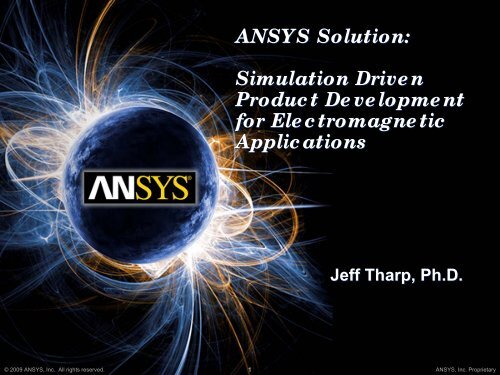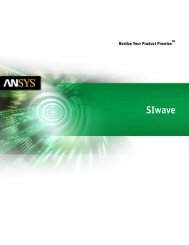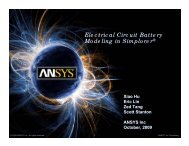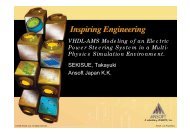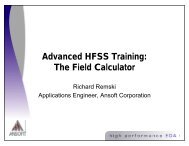Simulation Driven Product Development for Electromagnetic - Ansys
Simulation Driven Product Development for Electromagnetic - Ansys
Simulation Driven Product Development for Electromagnetic - Ansys
Create successful ePaper yourself
Turn your PDF publications into a flip-book with our unique Google optimized e-Paper software.
ANSYS Solution:<br />
<strong>Simulation</strong> <strong>Driven</strong><br />
<strong>Product</strong> <strong>Development</strong><br />
<strong>for</strong> <strong>Electromagnetic</strong><br />
Applications<br />
Jeff Tharp, Ph.D.<br />
© 2009 ANSYS, Inc. All rights reserved. 1 ANSYS, Inc. Proprietary
Outline<br />
• Introduction<br />
• Integration<br />
• <strong>Product</strong> Design Flow<br />
• <strong>Simulation</strong> <strong>Driven</strong> <strong>Product</strong> <strong>Development</strong> (SDPD)<br />
– SMA example<br />
• Conclusions<br />
© 2009 ANSYS, Inc. All rights reserved. 2 ANSYS, Inc. Proprietary
“What If?”<br />
• Where Achieving is the a good best solution? design often means making<br />
tradeoffs… • Per<strong>for</strong>mance ”What is If” scenarios<br />
– A optimized, good design but requires can not only that the<br />
per<strong>for</strong>mance it be reliablyquantity<br />
is optimized<br />
manufactured?<br />
• Per<strong>for</strong>mance must be maintained over expected<br />
• Will use parameter SMAvariations<br />
connector – Must know tohow<br />
multi-variable variation<br />
demonstrate impacts per<strong>for</strong>mance flow<br />
• Enables you to answer the “what-if” questions so<br />
the right decisions can be made based on accurate<br />
in<strong>for</strong>mation<br />
© 2009 ANSYS, Inc. All rights reserved. 3 ANSYS, Inc. Proprietary
Introduction<br />
• The release of HFSS12 and Workbench 12<br />
enables opportunity to enhance way engineers<br />
answer these questions<br />
• ANSYS Workbench<br />
– Intuitive multiphysics<br />
layout<br />
• HFSS12<br />
– Advanced EM extraction<br />
tool<br />
© 2009 ANSYS, Inc. All rights reserved. 4 ANSYS, Inc. Proprietary
Introduction: DesignXplorer<br />
• DesignXplorer (DX) is a tool <strong>for</strong> designing and<br />
understanding the analysis response of parts and<br />
assemblies<br />
–Account <strong>for</strong> uncertainties in product design<br />
• Six Sigma Analysis<br />
–Intuitively optimize a given problem<br />
• Goal <strong>Driven</strong> Optimization<br />
• DX explores a wide range of responses based on a<br />
limited number of actual solutions.<br />
–Uses Design of Experiments (DOE)<br />
–Functions with any input/output combination<br />
–Now including Ansoft products!<br />
© 2009 ANSYS, Inc. All rights reserved. 5 ANSYS, Inc. Proprietary
Introduction: DesignXplorer<br />
• The Response Surface Method allows <strong>for</strong> optimization and sixsigma<br />
studies efficiently<br />
• DX uses Design of Experiments (DOE)<br />
– DOE method determines how many, and which, design points<br />
should be solved <strong>for</strong> the most efficient approach to optimization<br />
– Many different DOE methods<br />
– Homogeneous and Inhomogeneous distributions<br />
– Response surface is fit to solved DOE<br />
© 2009 ANSYS, Inc. All rights reserved. 6 ANSYS, Inc. Proprietary
Introduction: DesignXplorer<br />
• EE’s are familiar with optimizations and<br />
benefits of Response Surfaces<br />
• What is Six-Sigma-Analysis?<br />
• Statistical analysis that takes the inherent<br />
tolerances of input parameters in a given<br />
component and determines the statistical<br />
distribution of the output parameters<br />
• What insight does this analysis bring?<br />
• Use Statistical Analysis to predict manufactured fail<br />
rates<br />
• Uses DOE and parameter tolerances to create a<br />
response surface<br />
© 2009 ANSYS, Inc. All rights reserved. 7 ANSYS, Inc. Proprietary
Integration<br />
• DX is a desired tool <strong>for</strong> efficient design flow…<br />
• DOE analysis enhances HFSS and other Ansoft<br />
tools<br />
– All solution space fit and mapped<br />
• Many DOE methods<br />
– Improved optimization capability and design insight<br />
• DX is available <strong>for</strong> all physics<br />
– All ANSYS solvers, Ansoft solvers, and third party<br />
tools can be brought into DX <strong>for</strong> design exploration<br />
– Ansoft tools integrated into interface…no scripting!<br />
© 2009 ANSYS, Inc. All rights reserved. 8 ANSYS, Inc. Proprietary
Integration<br />
• HFSS/DX integration is ideal combination<br />
• DX allows <strong>for</strong> FULL utilization of parametric analysis<br />
– Parametric analysis is efficiently guided by DX<br />
• Automated Adaptive Mesh ensures accurate solution<br />
<strong>for</strong> each variation…transparent to user<br />
– DSO allows <strong>for</strong> fast and DSO<br />
paralleled computation of the<br />
variations<br />
© 2009 ANSYS, Inc. All rights reserved. 9 ANSYS, Inc. Proprietary
<strong>Simulation</strong> <strong>Driven</strong> <strong>Product</strong><br />
<strong>Development</strong> (SDPD) Flow<br />
Design Variables<br />
-Input/Output<br />
Design of Experiments<br />
Response Surface<br />
Sensitivity<br />
Tradeoff<br />
Design Exploration<br />
Pareto Fronts<br />
Parameter<br />
Correlation<br />
Spider Plots<br />
Parallel Charts<br />
Optimization<br />
6σ Design of<br />
Experiments about<br />
Optimized Variation<br />
Response Surface<br />
Six Sigma Analysis<br />
Manufacture<br />
© 2009 ANSYS, Inc. All rights reserved. 10 ANSYS, Inc. Proprietary
<strong>Simulation</strong> <strong>Driven</strong> <strong>Product</strong><br />
<strong>Development</strong> (SDPD) Flow<br />
• Best way to demonstrate <strong>Simulation</strong> <strong>Driven</strong><br />
<strong>Product</strong> <strong>Development</strong> Flow is through<br />
example<br />
• SMA Connector<br />
© 2009 ANSYS, Inc. All rights reserved. 11 ANSYS, Inc. Proprietary
SDPD: SMA Optimization<br />
• SMA connector<br />
• Coax to microstrip<br />
transition<br />
• Goal is to minimize<br />
Return Loss at 12GHz<br />
• Manufacture <strong>for</strong> 6σ<br />
• 3 degrees of freedom<br />
Radius of transition pin<br />
[ 15 – 45 mil ]<br />
Length of transition pin<br />
[ 120 – 220 mil ]<br />
Antipad spacing<br />
[ 10 – 80 mil ]<br />
© 2009 ANSYS, Inc. All rights reserved. 12 ANSYS, Inc. Proprietary
SMA : Max/Min and Optimization<br />
• Used an Optimal-Space-Filling Design DOE<br />
– Inhomogeneous distribution of design<br />
variations<br />
– Can set the number of variations manually<br />
• Used 64 variations <strong>for</strong> DOE<br />
• Exported the DOE to a parametric sweep in HFSS!<br />
– Solved the Parametric sweep using DSO on a 16 core<br />
machine<br />
– Set the machines to<br />
use and chose to run with no<br />
graphics<br />
– All within the WB12 interface!<br />
© 2009 ANSYS, Inc. All rights reserved. 13 ANSYS, Inc. Proprietary
SMA : Max/Min and Optimization<br />
• Once DOE is solved, quickly see qualitative<br />
feedback of the solved points<br />
using the Parallel Parameters Plot!<br />
– Not based on response surface, just feedback<br />
from the solved<br />
points of the<br />
DOE!<br />
© 2009 ANSYS, Inc. All rights reserved. 14 ANSYS, Inc. Proprietary
SMA : Max/Min and Optimization<br />
• First step in optimization: What is the<br />
best/worst per<strong>for</strong>mance globally??<br />
– MAX/MIN search of DOE!<br />
– Begin with a screening optimization <strong>for</strong> ideal<br />
candidate<br />
designs<br />
based upon<br />
curve fit<br />
© 2009 ANSYS, Inc. All rights reserved. 15 ANSYS, Inc. Proprietary
SMA : Max/Min and Optimization<br />
• Take the soft Candidate design point and<br />
explicitly solve <strong>for</strong> hard reference!<br />
• The hard design is good…but we can do better<br />
• How does the rest of solution space look?<br />
– Tradeoff plot<br />
– Note ability <strong>for</strong> Design<br />
Exploration!<br />
• Local minima observed<br />
© 2009 ANSYS, Inc. All rights reserved. 16 ANSYS, Inc. Proprietary
SMA : Max/Min and Optimization<br />
• Specific Variable<br />
Tradeoff Plots<br />
• Alternative minima<br />
• Qualitative<br />
sensitivity from<br />
width of minima<br />
True Design Exploration!!<br />
© 2009 ANSYS, Inc. All rights reserved. 17 ANSYS, Inc. Proprietary
SMA : Max/Min and Optimization<br />
• Refine Optimization using the Multi-Objective<br />
Genetic Algorithm (MOGA)<br />
Pushed HFSS Explicit Solution <strong>for</strong> Candidate A (excellent correlation)<br />
• Looks like an excellent optimized design!<br />
– BUT: Can it be reliably manufactured ???<br />
© 2009 ANSYS, Inc. All rights reserved. 18 ANSYS, Inc. Proprietary
SMA: Six Sigma Analysis<br />
• Determine the stability of the per<strong>for</strong>mance <strong>for</strong><br />
optimized variation based on fabrication<br />
constraints<br />
– How reliable is this variation to mass produce<br />
and satisfy per<strong>for</strong>mance criteria using vendor<br />
6σ values <strong>for</strong> parameter tolerance?<br />
– How many failures per million manufactured?<br />
• Radius of transition pin ±5mils<br />
• Length of transition pin ±10mils<br />
• Spacing of Antipad ±2mils<br />
– Maximum allowed Return Loss -20dB<br />
© 2009 ANSYS, Inc. All rights reserved. 19 ANSYS, Inc. Proprietary
SMA: Six Sigma Analysis<br />
• Intuitive setup<br />
– Enter the mean<br />
value of parameter<br />
– Enter Distribution Type<br />
– Enter the standard<br />
deviation<br />
© 2009 ANSYS, Inc. All rights reserved. 20 ANSYS, Inc. Proprietary
SMA: Six Sigma Analysis<br />
• By using the vendor tolerances and applying a DOE in DX, can<br />
determine statistical expectations of per<strong>for</strong>mance!<br />
• In this case, 99.918% of SMA connectors will have Return Loss less<br />
than -20 dB!<br />
– Fail rate = 819 per million (3.15 σ) : Will need tighter vendor<br />
tolerances or other design <strong>for</strong> 3.4 per 1,000,000 (6σ)<br />
• 99.9934% will have RL less than -15dB (3.82 σ) -> 65.6 fail in 1 million<br />
• One gains much<br />
insight into the<br />
fabrication<br />
tolerances needed<br />
<strong>for</strong> desired<br />
manufactured<br />
per<strong>for</strong>mance!<br />
© 2009 ANSYS, Inc. All rights reserved. 21 ANSYS, Inc. Proprietary
SMA: Six Sigma Analysis<br />
• The Six Sigma Sensitivity also gives intuitive perspective as to<br />
which variable the per<strong>for</strong>mance is most sensitive!<br />
– Which variable needs the highest tolerance component?<br />
• COST MANAGEMENT through design!<br />
Variations in the radius of the<br />
transition pin have the most impact<br />
on per<strong>for</strong>mance at the optimized<br />
variation!<br />
© 2009 ANSYS, Inc. All rights reserved. 22 ANSYS, Inc. Proprietary
SMA: Optimization, DC to 15GHz<br />
• Same parameters and ranges as 12GHz case<br />
• Solved <strong>for</strong> three frequency ranges<br />
– DC – 5GHz, 5 – 10GHz,<br />
10 -15GHz, and whole band DC- 15GHz<br />
• Optimize Spectral Per<strong>for</strong>mance<br />
© 2009 ANSYS, Inc. All rights reserved. 23 ANSYS, Inc. Proprietary
SMA: Optimization, DC to 15GHz<br />
• Note the tradeoff of output variables of the<br />
reflection from DC to 5GHz and 10 – 15 GHz<br />
– As one gets better, other gets worse…<br />
© 2009 ANSYS, Inc. All rights reserved. 24 ANSYS, Inc. Proprietary
SMA: Optimization, DC to 15GHz<br />
• Pushed optimal variation to HFSS <strong>for</strong> hard<br />
reference<br />
• What are the design Sensitivities?<br />
DC to 5GHz 5 to 10GHz 10 to 15GHz<br />
DC to 15GHz<br />
© 2009 ANSYS, Inc. All rights reserved. 25 ANSYS, Inc. Proprietary
SMA: Six Sigma, DC to 15GHz<br />
• What are statistics of connectors with Return<br />
Loss less than -12.5 dB over DC to 15 GHZ<br />
– Same vendor tolerances and single freq case<br />
– 98% pass<br />
© 2009 ANSYS, Inc. All rights reserved. 26 ANSYS, Inc. Proprietary
Conclusions<br />
• Combining DesignXplorer with the<br />
capabilities of the Ansoft tools work together<br />
to give optimal design flow<br />
– <strong>Simulation</strong> <strong>Driven</strong> <strong>Product</strong> <strong>Development</strong>!<br />
• Complimentary combination<br />
– HFSS facilitates DOE, by solving parameter<br />
variations in parallel with DSO<br />
– Together… accurate and efficient solution <strong>for</strong><br />
optimized Design Analysis and Exploration<br />
© 2009 ANSYS, Inc. All rights reserved. 27 ANSYS, Inc. Proprietary
Conclusions<br />
• DX allows <strong>for</strong> total solution space analysis<br />
– A good design requires not only single<br />
optimized per<strong>for</strong>mance variation<br />
• In “real world”<br />
• Per<strong>for</strong>mance must be maintained over expected<br />
parameter variations due to vendor specs (SMA)<br />
– DX creates an accurate curve fit to represent<br />
the solution space with a minimum of solved<br />
response points!!<br />
• Faster and more robust optimizations<br />
• Much less likely to land in local minimum as whole<br />
solution space is represented<br />
• Accurate Six Sigma Analyses<br />
© 2009 ANSYS, Inc. All rights reserved. 28 ANSYS, Inc. Proprietary
ANSYS Solution:<br />
<strong>Simulation</strong> <strong>Driven</strong><br />
<strong>Product</strong> <strong>Development</strong><br />
<strong>for</strong> <strong>Electromagnetic</strong><br />
Applications<br />
Jeff Tharp, Ph.D.<br />
© 2009 ANSYS, Inc. All rights reserved. 29 ANSYS, Inc. Proprietary


